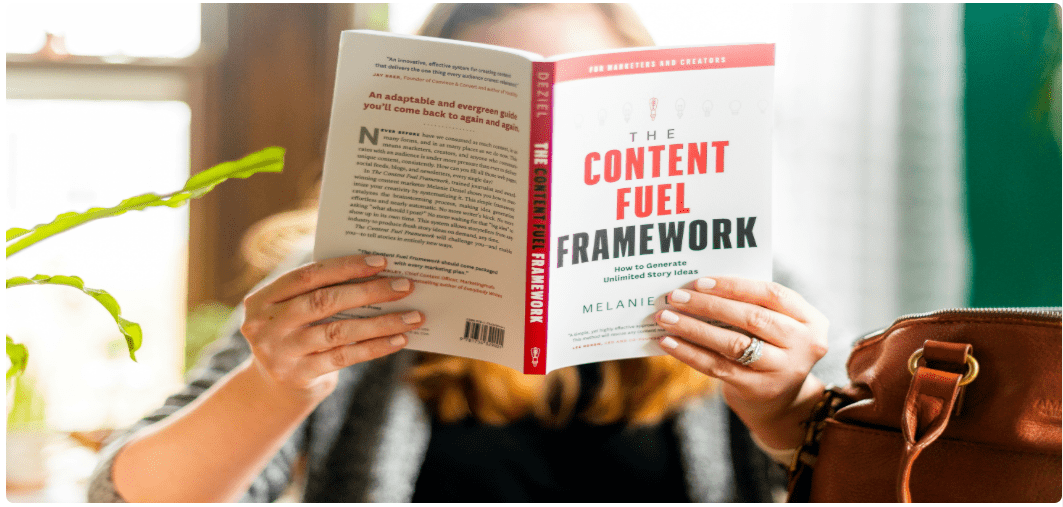Discover 3 most proven content writing examples with practical guide to boost engagement and SEO rankings. Actionable, data-backed guide.
1. Introduction
Content writing has evolved from simple blog posts into a powerful SEO and engagement engine. Today, content is not just about filling up a website—it’s about attracting readers, keeping them engaged, and turning them into loyal customers.
The challenge? Most “content writing examples” articles floating around are generic lists. They tell you that blog posts, case studies, or product pages matter—but they don’t show you why they work, how they drive rankings, or how to replicate them in your own strategy.
That’s exactly where this guide comes in.
👉 In this blog, you’ll find content examples backed by proven strategies, frameworks, and templates that you can copy-paste into your workflow. You’ll also see how tools like Keywordly.ai can simplify the entire process of creating high-performing, SEO-driven content.
2. Why Engagement and SEO Go Hand-in-Hand
Before diving into examples, it’s crucial to understand why engagement is inseparable from SEO success. You could publish hundreds of blog posts stuffed with keywords, but if users click away after five seconds, Google won’t reward you. Today, Google’s algorithm cares just as much about how readers interact with your content as it does about what’s in it.
How Google Measures Engagement
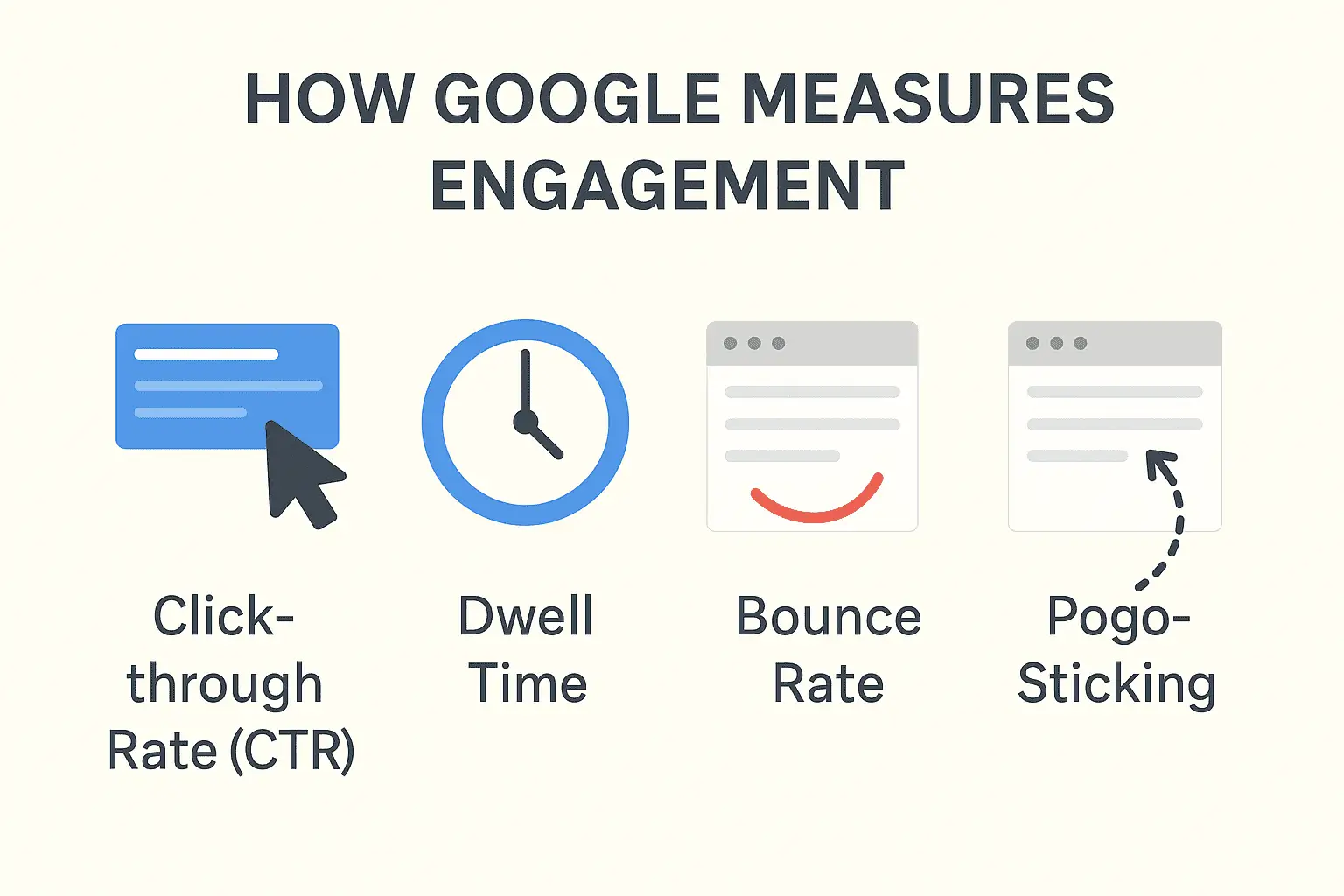
Google doesn’t openly list every ranking factor, but SEO research (from Backlinko, SEMrush, and Google’s own Search documentation) shows that user signals play a big role in rankings. Let’s break them down:
1. Click-through Rate (CTR)
- What it means: When your blog shows up in search results, do people actually click it?
- Why it matters: A high CTR tells Google that your content looks more relevant than competitors.
2. Dwell Time
- What it means: How long users spend on your page before returning to search results.
- Why it matters: If visitors stay for 5 minutes instead of 5 seconds, Google assumes your content solved their problem.
3. Bounce Rate
- What it means: The percentage of visitors who leave your site after viewing just one page.
- Why it matters: A high bounce rate signals that readers didn’t find what they expected.
4. Pogo-Sticking
- What it means: When users click your result, leave quickly, and then click another result on the SERP.
- Why it matters: It’s a strong negative signal that your content wasn’t helpful.
Why Engagement Matters for Rankings
- Engaged readers stay longer → Google sees your content as valuable and rewards it with higher rankings.
- Engaged readers share your content → Earns backlinks and social proof.
- Engaging formats keep users scrolling → Signals freshness and relevance.
3. Content Writing Examples That Drive Engagement + Rankings
When it comes to content writing, not all formats are created equal. Some attract clicks but fail to keep readers engaged. Others generate engagement but don’t rank well. The sweet spot is creating formats that do both.
Here are proven content types that consistently deliver rankings and engagement.
3.1 Blog Posts Optimized for SEO + Skimmability
What it is:
These are long-form, SEO-friendly articles crafted to educate and solve reader problems while being easy to skim. They go beyond keyword stuffing by combining structure, visuals, and readability.
Why it works:
- Engagement boost: Complex topics are broken into bite-sized, digestible sections → readers stay longer.
- SEO boost: Includes schema, FAQs, and keyword-rich subheadings → Google understands the content better.
- Trust boost: Stats, examples, and visuals reinforce credibility → reducing bounce rates.
3.2 Case Studies (High Conversion)
What it is:
Case studies showcase real customer success stories—how your product/service solved a problem and delivered measurable results. They’re high-value, bottom-of-funnel (BOFU) content designed to persuade prospects.
Why it works:
- Engagement boost: Stories are inherently engaging → readers connect with real people and results.
- SEO boost: Targets transactional queries like “CRM software case study” or “HubSpot success stories.”
- Conversion boost: Builds trust and reduces objections by proving outcomes.
3.3 Product Comparisons & Listicles
What it is:
These are “X vs Y” articles or “Top 10 Best Tools” listicles designed to help users make purchase decisions. They’re powerful for capturing commercial intent traffic—people ready to buy.
Why it works:
- Engagement boost: Readers spend longer comparing side-by-side features, pros, and cons.
- SEO boost: Captures high-intent keywords like “best SEO tools,” “Ahrefs vs Semrush,” “Grammarly alternatives.”
- Monetization boost: Drives affiliate clicks, free trial signups, or demo requests.
4. Breakdown of Key Content Frameworks + SEO Elements
You’ve seen how different content formats (blogs, case studies, comparisons) can drive engagement and rankings. But behind every successful piece of content is a framework—a set of repeatable elements that make it engaging for readers and optimized for search engines.
Let’s break down the must-have elements and why they matter:
4.1 Headline Optimization → Power Words + Primary Keyword
Your headline is the first impression—both for readers and Google.
- Why it matters for engagement:
A strong headline stops the scroll, sparks curiosity, and compels clicks. If the headline doesn’t resonate, even the best article won’t get read. - Why it matters for SEO:
Including your primary keyword in the headline helps Google understand your topic and increases visibility in the SERP.
4.2 Strong Introduction → Hook, Problem, Promise
The intro sets the tone and determines whether readers stay or bounce.
- Why it matters for engagement:
A compelling intro creates an emotional connection. By stating the problem and promising a solution, you give readers a reason to keep scrolling. - Why it matters for SEO:
Google tracks dwell time. If users bounce right after reading the intro, rankings drop. A strong opening keeps them on the page longer.
4.3 Clear H2/H3 Hierarchy → Skimmability + SEO
Nobody wants to face a wall of text. A logical heading structure makes content easy to scan.
- Why it matters for engagement:
Readers skim before they commit. Well-placed H2s/H3s let them quickly find what they need, reducing bounce rates. - Why it matters for SEO:
Search engines use headings to understand content hierarchy and topic coverage. Keywords in H2s/H3s improve relevance.
4.4 Internal Linking → Crawlability + Retention
Links aren’t just for navigation—they’re a powerful SEO weapon.
- Why it matters for engagement:
Internal links guide readers deeper into your site, reducing bounce rates and increasing session time. - Why it matters for SEO:
Google crawls through links. A strong internal linking structure helps distribute authority (PageRank) and improves crawlability.
4.5 Visuals & Data → EEAT Credibility + Engagement
Plain text is boring. Visuals, infographics, and charts keep readers hooked and help explain complex points.
- Why it matters for engagement:
Articles with visuals get 94% more views and readers retain info better. Data-backed content builds trust. - Why it matters for SEO:
Google favors content that demonstrates E-E-A-T (Experience, Expertise, Authoritativeness, Trustworthiness). Using stats, charts, and cited sources adds authority.
4.6 Engagement Hooks → Questions, Storytelling, Polls
Readers are passive by default—engagement hooks make them active participants.
- Why it matters for engagement:
Asking questions, telling stories, or adding polls/quizzes keeps users scrolling, clicking, and interacting. - Why it matters for SEO:
Engagement reduces bounce rates and improves dwell time → Google interprets this as quality content.
4.7 SEO Enhancers → Schema, Meta, Alt Text
Small details = big SEO impact.
- Why it matters for engagement:
A clear meta description improves CTR. Alt text makes content accessible (good UX). - Why it matters for SEO:
- FAQ Schema → enables rich snippets in Google (higher visibility).
- Meta Descriptions → encourage clicks, boosting CTR.
- Alt Text → improves image search visibility and accessibility.
Example: Adding FAQ schema to your blog can get you featured as a rich result, driving more traffic.
Every successful content piece isn’t just written—it’s engineered with these frameworks. Miss one element, and your rankings or engagement can suffer.
5. How Keywordly.ai Helps Create High-Engagement SEO Content
Most AI tools stop at “content generation.” Keywordly.ai goes further — it’s a complete SEO content workflow platform that ensures every article you publish is both engaging for readers and optimized for rankings.
Here’s how:
🔹 Content Type Templates
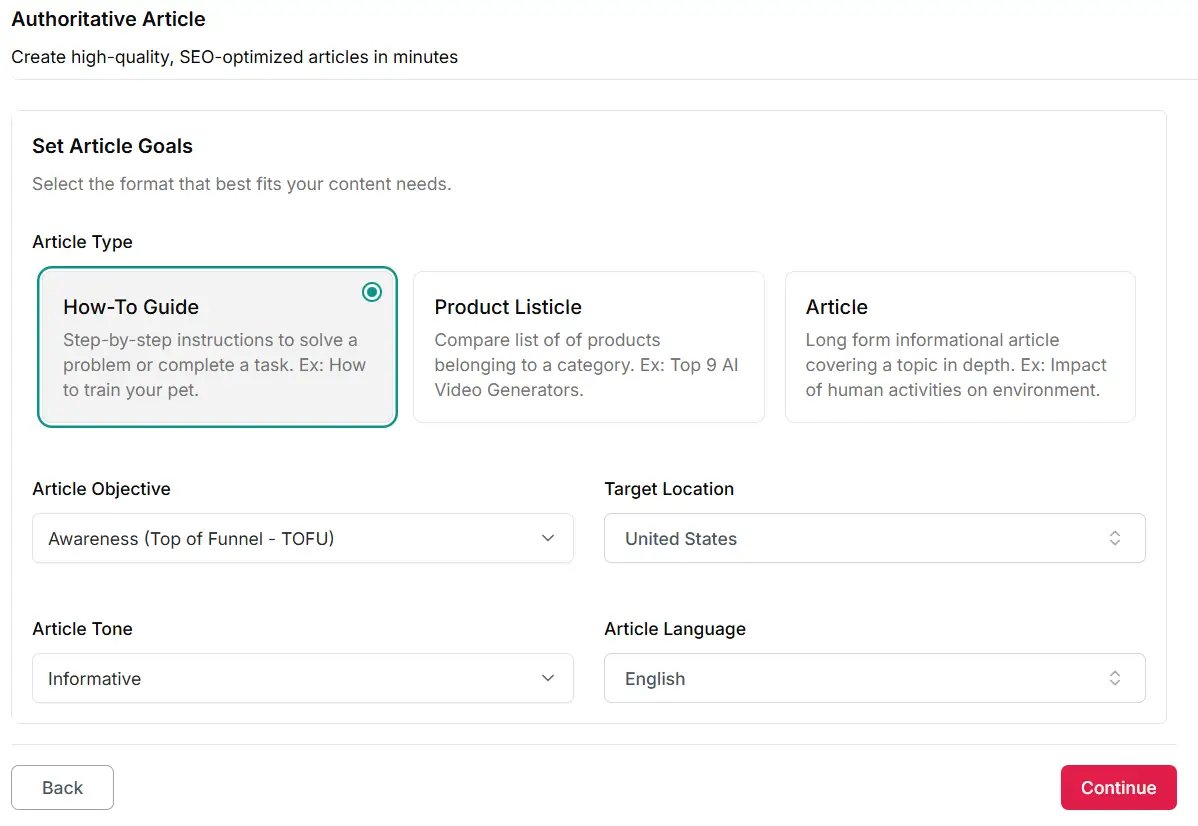
No need to start from scratch. Keywordly.ai comes with ready-to-use article types for blog posts,Product listicles and long-form articles. This ensures your content is structured, skimmable, and SEO-friendly right from the first draft.
🔹 Dual Modes of Content Generation
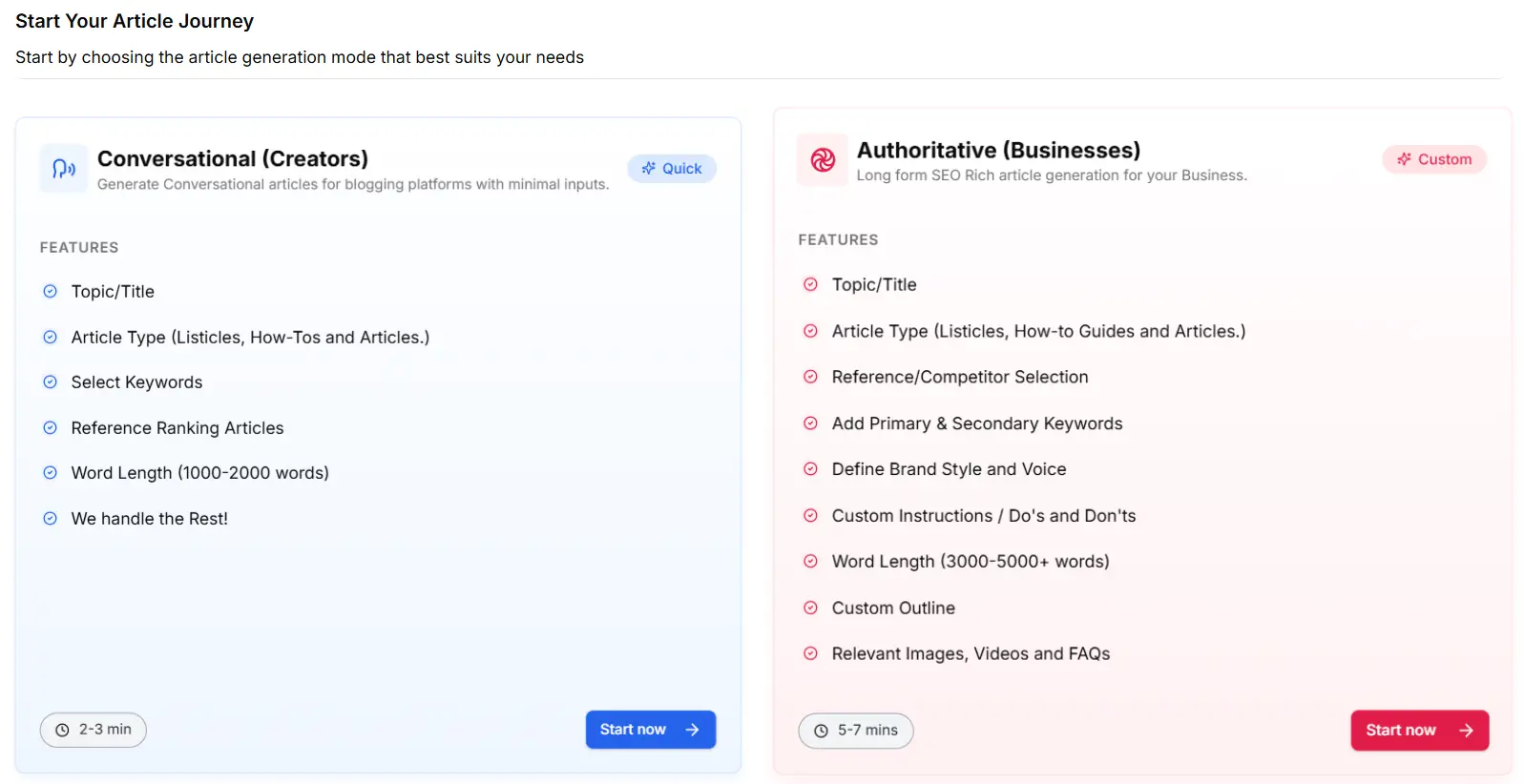
Keywordly.ai understands that not all content serves the same purpose. That’s why it offers two distinct modes:
- Conversational Mode → Great for blogs that need a natural, storytelling style (perfect for thought leadership or brand building).
- SEO Long-Form Mode → Ideal for in-depth guides, product comparisons, or keyword-heavy blogs designed to capture rankings.
Within long-form mode, you can choose the exact format you need:
- How-to guides
- Product listicles
- Authoritative long-form articles
👉 This flexibility means you don’t need to worry about picking the “perfect” content type upfront—you can experiment with multiple formats until you hit the sweet spot that drives results.
🔹 SEO Keyword Suggestions
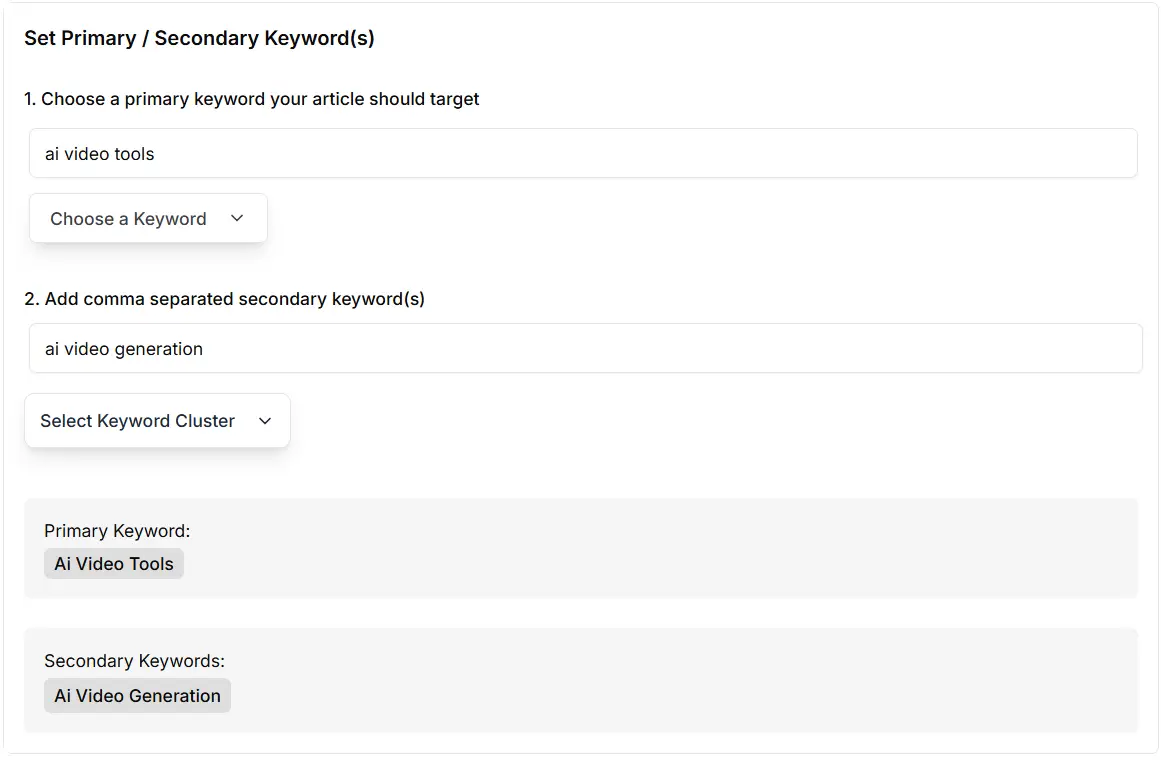
Keywordly.ai automatically pulls in primary, secondary, and related keywords to maximize topical relevance. It also helps you cluster keywords into themes, ensuring your content has depth and authority (boosting your chances of ranking for multiple terms).
🔹 Engagement Features
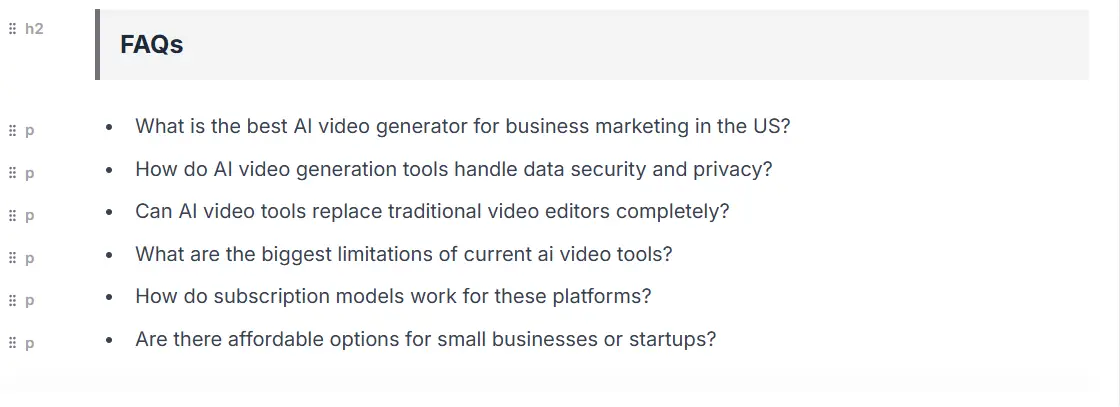
Beyond SEO, Keywordly.ai makes sure your content hooks readers and keeps them engaged by recommending:
- FAQs for skimmability + SEO (with schema-ready formatting)
- CTAs to drive conversions
- Internal linking opportunities to reduce bounce rate and improve crawlability
🔹 One-Click Optimization
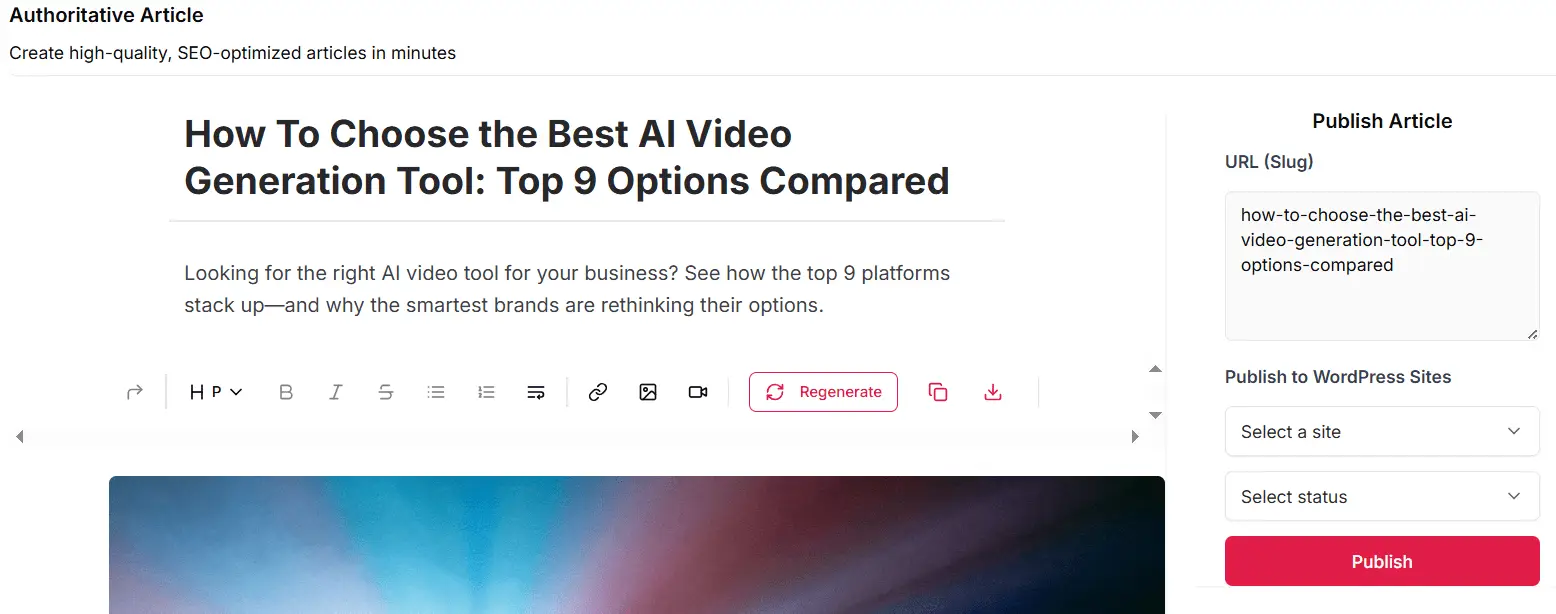
Before publishing, Keywordly.ai runs your draft through an SEO + engagement checklist that fine-tunes:
- Meta descriptions
- Title tags with power words
- Readability scores
- Alt text for images
This ensures your content is not just written—but also ready to rank.
🔹 Workflow Automation
From planning your content calendar to hitting publish, everything happens inside Keywordly.ai. The Plan → Write/ Revamp existing content → Optimize → Publish workflow removes the need for juggling multiple tools.
6. Bringing It All Together with SEO Content Frameworks
Remember the Breakdown of Key Content Frameworks + SEO Elements we discussed earlier? Keywordly.ai builds them directly into its workflow, The real challenge? Most writers have to juggle multiple tools and spreadsheets, to get it right.
Keywordly.ai solves this by baking each framework directly into the workflow:
- Headline Optimization
→ Instead of guessing, Keywordly.ai generates multiple headline variations using power words, numbers, and your primary keyword. You can instantly pick one from the entire list of recommendations Keywordly has to provide. - Strong Introductions
→ It creates strong introductions that grab attention within the first 100 words, increasing dwell time and reducing bounce rate. - H2/H3 Hierarchy
→ Keywordly.ai auto-structures your draft with logical subheadings, making it skimmable for readers and crawlable for search engines. You don’t need to worry about messy formatting—it’s done for you. - Internal Linking Suggestions
→ The tool scans your existing site content and recommends internal links to keep readers browsing longer (and strengthen your site architecture for SEO). - Visual + Data Prompts
→ Keywordly.ai tells you exactly where to insert charts, screenshots, or case studies to make the piece more authoritative and engaging. In Keywordly’s authoritative blog you don’t have to worry about the visuals, keywordly has got you covered with the AI generated images in place. - For product listicles, Keywordly automatically provides snapshots of the respective products, so you don’t have to worry about finding them yourself.
- SEO Enhancers
→ It automates technical polish:
- Schema-ready FAQs (for featured snippets)
- Optimized meta descriptions with keyword + CTA
- Alt text for every image is already in place
- Schema-ready FAQs (for featured snippets)
👉 In short, Keywordly.ai doesn’t just generate text—it bakes in the proven SEO + engagement framework to give your content the best chance of ranking and keeping readers hooked.
7. Conclusion
Content writing isn’t just about volume—it’s about engagement and rankings working hand in hand.
We’ve seen that blog posts, case studies, Product Listicles, and interactive content are the formats that:
- Keep users on-page longer
- Generate backlinks and shares
- Capture leads and conversions
- Signal value to Google for higher rankings
With Keywordly.ai, you don’t have to start from scratch. You can leverage Article type, optimization tools, and workflows to create high-performing content at scale.
👉 Try one content type this week, and watch your engagement and rankings grow. Download the guide below.
Download Guide
Enter your email below to receive your Guide.
Faqs
Why are user engagement signals vital for SEO performance?
Google values more than just keywords—it assesses how users interact with content. Key metrics include:
- Click-Through Rate (CTR) – indicates relevance in search results.
- Dwell Time – longer visits signal that content meets reader needs.
- Bounce Rate & Pogo-Sticking – high rates or quick returns to search results serve as red flags of unsatisfactory content.
Engaged readers translate to higher rankings and organic visibility.
How does Keywordly.ai help you implement these content frameworks effectively?
Keywordly.ai serves as a comprehensive SEO content workflow platform by offering:
- Content type templates (blogs, listicles, long-form) that ensure structure, skimmability, and optimization from the start.
- Dual content generation modes:
- Conversational Mode for storytelling and thought-leadership pieces.
- SEO Long-Form Mode for detailed guides, comparisons, or keyword-focused blogs.
- SEO recommendations including primary, secondary, and related keywords grouped into clusters for topical depth.
- Engagement tools such as FAQ suggestions, CTAs, and internal linking prompts.
- One-click optimization for meta tags, titles with impactful words, readability enhancements, and image alt text
How can I apply these strategies to elevate my own content?
Here’s a quick application guide:
- Choose the right format: pick blog articles, case studies, or comparisons based on your audience’s stage in the funnel.
- Structure for engagement: craft clickable headlines, hook-driven introductions, and readable sections with data or visuals.
- Optimize for SEO: weave in keywords, apply schema markup, use meta descriptions, and internal links.
- Use Keywordly.ai for efficiency: leverage its templates, content generation, SEO suggestions, and refinement tools—so your content is both reader-friendly and search-ready.
